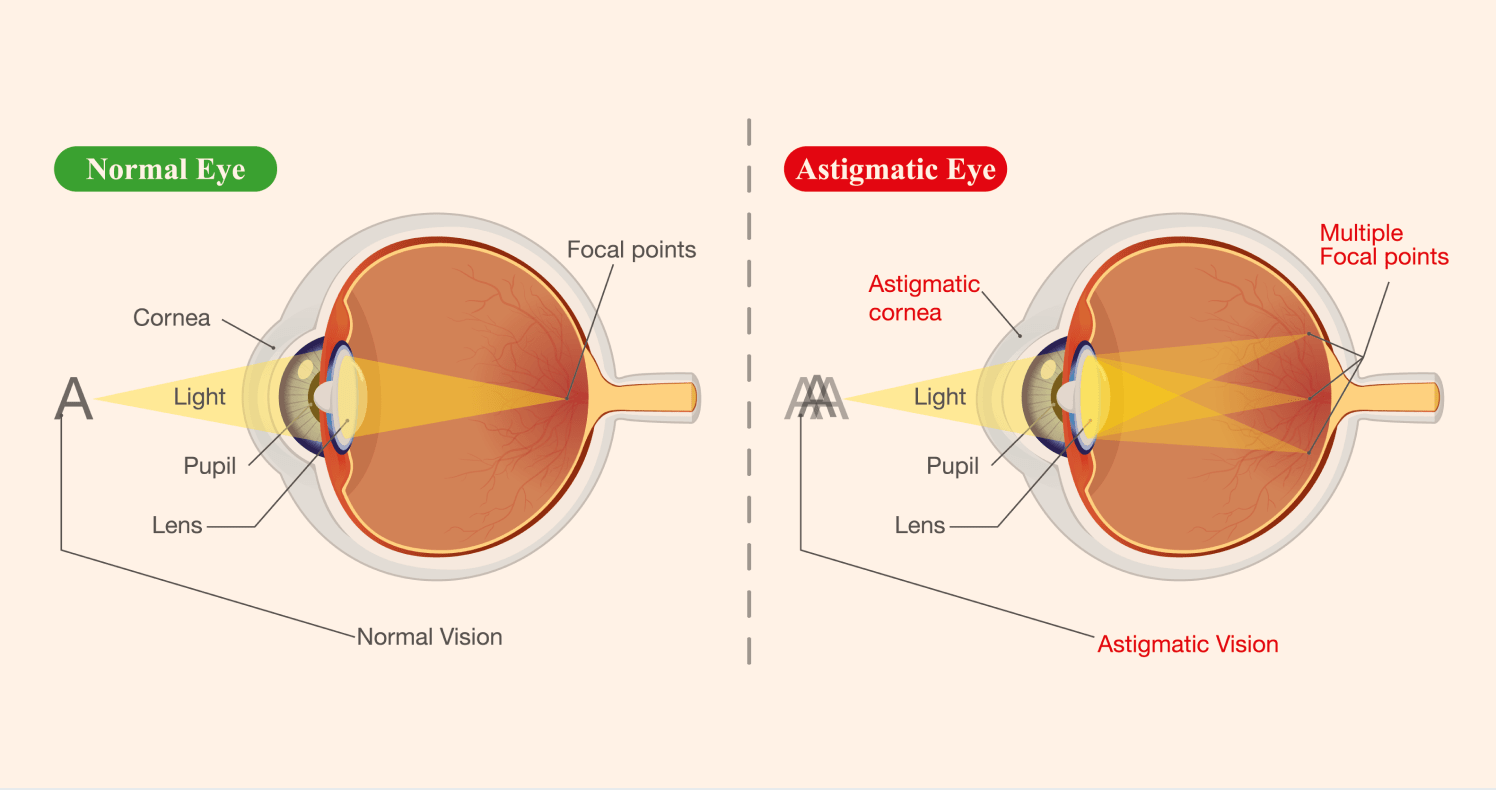Discover the most common astigmatism symptoms, causes, and treatments
Updated JAN 26, 2023 • 3 min read

Summary in 30 seconds
What is astigmatism? We’re covering the causes of astigmatism, symptoms of astigmatism, treatments, and all the useful tips needed to manage this common condition.
In an ideal world, your eyeball would be perfectly round, infiltrating light that bends evenly. The result being crystal clear vision.
For the majority of the population, our eyeballs aren’t a perfect, round ball. This means that light will refract (bend) more in one direction than another, causing objects to look blurry as only part of them are in focus. This is astigmatism.
Jump to content
- What causes astigmatism?
- Rare causes of Astigmatism
- Common misconception
- What are the symptoms of astigmatism?
- Astigmatism in children’s eyes
- How do you treat astigmatism?
- Can Lasik Fix Astigmatism?
- Main takeaways
What causes astigmatism?
Most cases of astigmatism are hereditary. They typically derive from birth, and develop slowly. Other causes can be from:
- Injury to the eye
- Eye disease
- Surgery such as cataracts

Rare causes of astigmatism
Another possible cause of astigmatism is a rare condition called Keratoconus, whereby the structure of the cornea (that’s the clear, outer lens of your eye) isn’t strong enough to hold its round shape, and bulges like a cone.
Common misconception
A common misconception is that reading in low lighting or sitting too close to the television can cause astigmatism. This is not actually true, and most likely a tool our parents used to have us move further away from our cartoons!

What are the symptoms of astigmatism?
Symptoms of astigmatism can differ in each person, with some cases actually being asymptomatic. There are a few common symptoms reported with astigmatism to look out for.
- Blurred or distorted vision is probably the most common symptom, and can occur with both nearsightedness and farsightedness
- Eye strain usually happens when there’s an inability to see both near and far clearly. Meaning vision is clearer looking at objects far away, and requires squinting to focus at near objects; and vice versa
- Left untreated, headaches and fatigue are obvious symptoms of astigmatism, usually as a result of straining the eyes for extended periods of time
- One of the more bothersome symptoms is difficulty seeing at night. This is because the condition worsens in low light conditions, as the pupil dilates in need of more light. Drivers with astigmatism will often see halos and glare at night, which can make being on the road dangerous
- Similarly, wet conditions also cause glare, so difficulty driving in rain can also be common for someone with astigmatism
Astigmatism in children’s eyes
It’s worth noting that children may not recognize symptoms of astigmatism. If they are used to only seeing the world out of focus, they won’t identify this as a problem. It is therefore important to check their vision regularly.
Treatment begins with an astigmatism test
Treatment is easy, and starts by going to the eye doctor in order to detect and diagnose the condition, in this case being astigmatism. Through a series of tests, your doctor will determine how the eyes bend light, and thus the prescription necessary to correct your astigmatism and/or other refractions, if there are any.
How do you treat astigmatism?
Fortunately, treatment is easy. After an astigmatism test, the most common way to correct astigmatism associated with blurred vison is with corrective eyeglasses or contact lenses such as these Acuvue Oasys for Astigmatism. With the appropriate prescription, perfect vision or substantial improvement can be achieved, as long as the corrective lenses are in use. Optometrists recommend annual eye exams to monitor the health of your eyes and ensure you are using the correct prescription.
Can Lasik Fix Astigmatism?
For those looking beyond treatment the option of LASIK laser surgery is a highly successful one. It works by reshaping the cornea, allowing light to focus correctly on the retina (the tissue lining the back of the eye).
Laser surgery is not suitable for everyone, however. A full consultation with your eye doctor will outline all the risks and benefits, and determine whether or not you are a viable candidate to use Lasik to Fix astigmatism.
Main takeaways
Astigmatism on the whole is extremely common, easily diagnosed with routine tests, and treatable. It shouldn’t negatively impact your day-to-day life, provided it’s managed properly.
If you think you may be experiencing the above mentioned, or any other symptoms, please schedule an appointment with your eye doctor.
Published June 26, 2022|Updated January 26, 2023

Victoria Landsmann



 Oversized
Oversized
 Aviator
Aviator
 Wayfarer
Wayfarer
 Rimless
Rimless
 Cat Eye
Cat Eye
 Round
Round